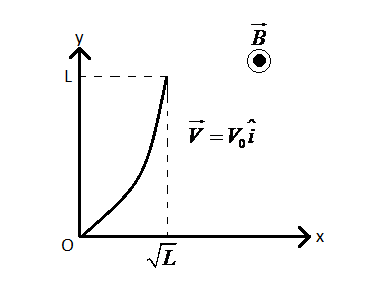Question
Question: A conducting wire of parabolic shape, \(y={{x}^{2}}\), is moving with velocity \(\overrightarrow{V}=...
A conducting wire of parabolic shape, y=x2, is moving with velocity V=V0i in a non-uniform magnetic field B=B0(1+(Ly)β)k, as shown in the figure. If V0,B0,L and β are positive constants and Δϕ is the potential difference developed between the ends of the wire, then the correct statement(s) is/are?

(This question has multiple correct options)
A) ∣Δϕ∣=34B0V0L for β=2
B) ∣Δϕ∣ remains the same if the parabolic wire is replaced by a straight wire, y=x, initially of length 2L
C) ∣Δϕ∣=21B0V0L for β=0
D) ∣Δϕ∣ is proportional to the length of the wire projected on the y-axis.
Solution
The motional emf generated in the wire can be found out by integrating the infinitesimal emf developed in an infinitesimal part of the wire that is orthogonal to the velocity and the magnetic field, that is the infinitesimal length projected upon the y-axis and then integrating it for the whole wire.
Formula used:
∣Δϕ∣=Bvlsinθ
Complete step by step answer:
The motional emf ∣Δϕ∣generated in a wire of length l moving with a velocity v in the presence of a magnetic field B that is perpendicular to the plane of the wire and its velocity is given by
∣Δϕ∣=Bvlsinθ --(1)
Where θ is the angle between the length of the wire and the direction of its velocity.
To find the motional emf generated in the wire, we have to consider the length of the wire that is perpendicular to the velocity and the magnetic field (that is component of the length along the y-axis). By doing this we will be essentially making θ=900,sinθ=1 in equation (1).
Hence, let us proceed to do that.
Let the infinitesimal emf generated in an infinitesimal vertical projection dy of the length of the wire in the magnetic field B=B0(1+(Ly)β)k be ∣dε∣.
The velocity of the wire is V=V0i.
Hence, using (1), we get
∣dε∣=B0(1+Ly)βV0dysin900=B0(1+(Ly)β)V0dy(1)=B0(1+(Ly)β)V0dy (∵sin900=1) --(2)
Now integrating (2), for the whole wire, we get
0∫∣Δϕ∣∣dε∣=0∫LB0(1+(Ly)β)V0dy=B0V00∫L(1+(Ly)β)dy --(3)
0∫∣Δϕ∣∣dε∣=B0V00∫L(dy+(Ly)βdy)
0∫∣Δϕ∣∣dε∣=B0V0[[y]0L+Lβ1(β+1yβ+1)0L]=B0V0[[L−0]+Lβ1(β+1Lβ+1−0)0L]=B0V0[L+Lβ1(β+1Lβ+1)]=B0V0[L+(β+1L)]=B0V0L(1+β+11)
--- (4)
Now, let us analyze the options.
A) ∣Δϕ∣=34B0V0L for β=2. Let us check this.
Putting β=2 in (4), we get
∣Δϕ∣=B0V0L[1+2+11]=B0V0L(1+31)=B0V0L(33+1)=B0V0L(34)=34B0V0L
Therefore, option (A) is correct.
B) ∣Δϕ∣ remains the same if the parabolic wire is replaced by a straight wire, y=x, initially of length 2L
If the wire is replaced by a straight wire length 2L, the vertical projection will be 2Lsin450=2L×21=L (∵y=x, makes an angle of 450 with the x-axis, sin450=21)
Hence, we can see that the vertical projection is still L which is the same as that of the parabolic wire as can be seen from (4). Therefore, ∣Δϕ∣ will remain the same.
C) ∣Δϕ∣=21B0V0L for β=0
Putting β=0 in (4), we get
∣Δϕ∣=B0V0L[1+0+11]=B0V0L(1+11)=B0V0L(2)=2B0V0L
Hence, option C) is wrong.
D) ∣Δϕ∣ is proportional to the length of the wire projected on the y-axis.
From (4), we can see that ∣Δϕ∣ is proportional to the length of the wire projected on the y-axis.
Therefore, option D) is correct.
Note:
Complex problems involving motional emf should be approached by finding out the length, velocity and magnetic fields and placing them such, by taking components or otherwise so that a mutually orthogonal system is obtained. Then we can find the motional emf by integration of an infinitesimal length of the wire. This will make the problem a lot easier and give a direction for the students to proceed when faced with such problems that seem overwhelming at the first glance.
